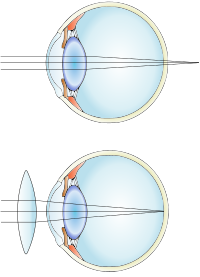
Photo from wikipedia
Purpose To evaluate the association between axial length and crystalline lens biometry with and without accommodation using the CASIA2 swept-source (SS) optical coherence tomography (OCT) system on the anterior segment.… Click to show full abstract
Purpose To evaluate the association between axial length and crystalline lens biometry with and without accommodation using the CASIA2 swept-source (SS) optical coherence tomography (OCT) system on the anterior segment. Study design Intervention study. Methods Individuals aged 20 to 39 years were enrolled for SS-OCT imaging at 2 separate visits within 1 week. Each eye was imaged under accommodation stimuli with different amplitudes (0 D, -1 D, -3 D, -5 D, and -7 D). The anterior and posterior lens curvature radii and lens thicknesses were measured. The participants were divided into 4 groups according to axial length. Results Forty-eight participants (96 eyes) were initially enrolled. All 96 eyes were included in the analyses, as they met the eligibility criteria and each had proper OCT images. The mean participant age was 25.9 ± 4.3 years, and the mean spherical error was -3.5 ± 2.5 D. The mean axial length was 25.1 ± 1.2 mm. Multivariate analysis revealed that the anterior curvature radius became flatter and the lens thickness became thicker as the axial length increased (all P < .01). Furthermore, axial length independently contributed to the shape of the lens after adjusting for the effects of age and accommodation stimuli. Conclusion Axial length was associated with lens shape after adjusting for age and accommodation stimuli. These measurements can provide a glimpse of dynamic lens biometry changes, which may help us better understand the role of lenses in various physiologic changes, including accommodation and myopia.
Journal Title: Japanese Journal of Ophthalmology
Year Published: 2019
Link to full text (if available)
Share on Social Media: Sign Up to like & get
recommendations!